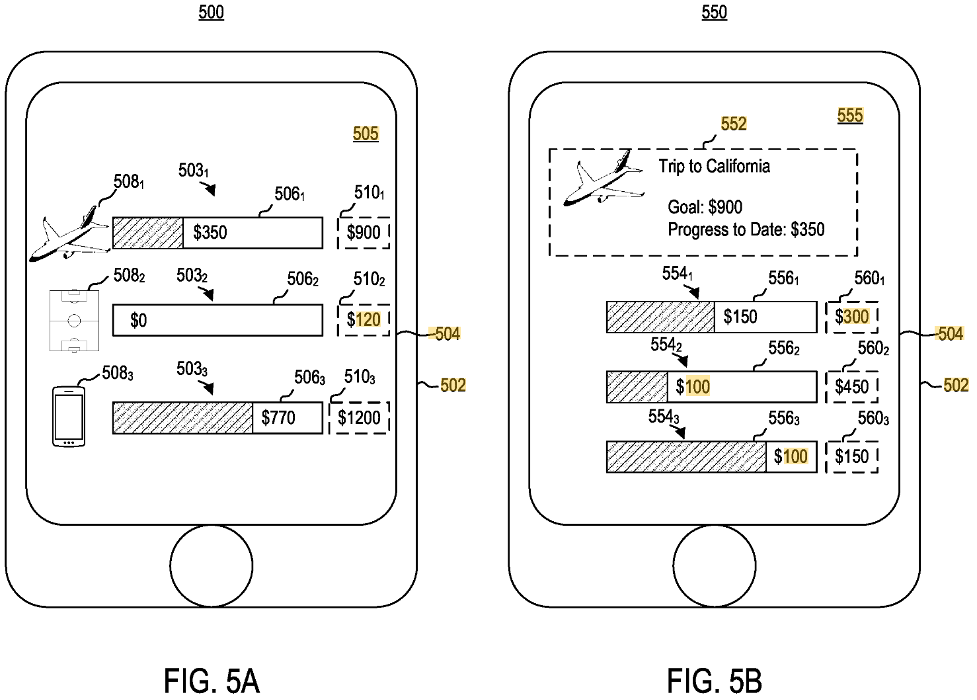PTAB: Ex parte Joshua Edwards
Certain methods of organizing human activity, Transformation of an abstract idea into a patent-eligible application
PTAB Appeal 2022-000977
Abstract from Application on Appeal
Embodiments disclosed herein generally related to a system and method for generating a dynamic graphical user interface (GUI). The system identifies at least one financial goal of the user. The system generates a target savings amount for the at least one financial goal based at least on one or more spending habits of the user. The system generates a GUI. The GUI includes at least one gamification element corresponding to the at least one financial goal. The at least one gamification element visually depicts progress towards the savings amount. The system receives at least one account event. The system updates the GUI by adjusting the gamification element to depict an updated progress towards the savings amount.

Representative Claim on Appeal
An account management system, comprising:
- [1] a processor in communication with a client device of a user; and
- [2] a memory having programming instructions stored thereon, which, when executed by the processor performs an operation, comprising:
- [3] training a prediction model to identify financial goals and spending habits of the user by:
- [4] generating a training data set comprising account activity of the user, the account activity comprising chat bot interactions of the user, email correspondence between the user and an entity associated with the account management system, and historical transaction data of the user, and further account activity of other users similar to the user, the further account activity comprising further chat bot interactions of the other users similar to the user, further email correspondence between the other users similar to the user and the entity associated with the account management system, and further historical transaction data of the other users similar to the user,
- [5] learning, by the prediction model, to identify a financial goal of the user based on the training data set,
- [6] learning, by the prediction model, a cost associated with each financial goal of the user based on the training data set, and
- [7] learning, by the prediction model, an estimated timeline for reaching each financial goal of the user based on the training data set and the cost associated with each respective financial goal;
- [8] identifying, by the prediction model, at least one financial goal of the user by:
- [9] analyzing one or more accounts of the user to identify one or more transactions;
- [10] identifying at least one product or service for which the user has transacted above a threshold number of times; and
- [11] setting the at least one product or service as the at least one financial goal;
- [12] generating, by the prediction model, a target savings amount for the at least one financial goal based on one or more spending habits of the user and one or more spending habits of other users unrelated to the user;
- [13] generating, by the prediction model, an estimated timeline for reaching the target savings amount by learning based on the one or more spending habits of the user and the target savings amount; [14] generating a graphical user interface (GUI) comprising a first gamification element corresponding to the at least one financial goal and a second gamification element corresponding to the estimated timeline, the first gamification element and the second gamification element visually depicting progress towards the savings amount;
- [15] receiving at least one account event; and
- [16] updating, in real-time, the GUI by adjusting the first gamification element and the second gamification element in real-time to depict an updated progress towards the savings amount.
Rejection of Claims on Appeal
The Examiner rejected the claims under 35 U.S.C. § 101, arguing that they were directed to the judicial exceptions of organizing human activity and mental processes without significantly more to transform the abstract idea into a practical application. The Appellant contended that the claimed invention was not directed to the abstract idea of a to a specific and practical application of an account management system that improved the user’s experience in managing their finances.
Summary of Appeal Analysis
The United States Patent and Trademark Office’s (USPTO) Patent Trial and Appeal Board (PTAB) affirmed the Examiner’s decision to reject claims concerning an account management system that featured a dynamic graphical user interface (GUI) for managing personal finances. The system involved a prediction model, gamification elements, and real-time updates to help users monitor their financial accounts, goals, and recommendations. The examiner asserted that the claimed subject matter would be considered a method of organizing human activity.
The Examiner rejected the claims under 35 U.S.C. § 101, arguing that they were directed to a judicial exception without significantly more. The Appellant contended that the recited a specific and practical application of an account management system that improved the user’s experience in managing their finances using a graphical user interface.
The PTAB applied the two-part framework to determine if the claim fell within an excluded category. In the first step, they found that the claim was directed to an abstract idea – managing personal finances, a fundamental economic practice categorized as certain methods of organizing human activity. In the second step, they analyzed whether the claim included any additional elements that provided an inventive concept or amounted to significantly more than the abstract idea itself.
Despite the Appellant’s arguments, the PTAB concluded that the claim’s additional elements, such as the prediction model, gamification elements, and real-time updates, did not provide an inventive concept sufficient to transform the abstract idea into a patent-eligible application. As a result, the PTAB affirmed the Examiner’s rejection of the claims under 35 U.S.C. § 101.
